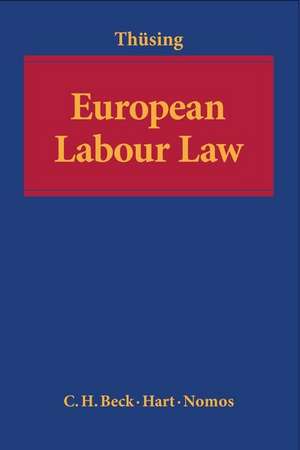European Labour Law
Autor Gregor Thusingen Limba Engleză Paperback – 31 oct 2013
Preț: 656.47 lei
Preț vechi: 943.11 lei
-30% Nou
Puncte Express: 985
Preț estimativ în valută:
125.62€ • 131.42$ • 104.35£
125.62€ • 131.42$ • 104.35£
Carte disponibilă
Livrare economică 13-27 martie
Preluare comenzi: 021 569.72.76
Specificații
ISBN-13: 9781849464888
ISBN-10: 184946488X
Pagini: 260
Dimensiuni: 165 x 236 x 18 mm
Greutate: 0.5 kg
Ediția:New.
Editura: Beck/Hart
Locul publicării:London, United Kingdom
ISBN-10: 184946488X
Pagini: 260
Dimensiuni: 165 x 236 x 18 mm
Greutate: 0.5 kg
Ediția:New.
Editura: Beck/Hart
Locul publicării:London, United Kingdom
Caracteristici
This textbook outlines the current state of European Labour Law.References have been deliberately kept to a minimum in the book, instead numerous examples and a summary of the most significant judgments of the ECJ vividly illustrate the contentious issues.A useful tool for anyone wanting an up-to-date guide to European Labour Law.
Notă biografică
Gregor Thüsing is Professor of Labour Law and Social Security Law at the University of Bonn.
Cuprins
§ 1. Basics I. What is European Labour Law? II. Development of European Labour Law III. To recap: The terms used in European Law IV. To recap: Interpretation of European Law V. What can the EU regulate in the field of labour law? VI. Means of reviewing conformity with European Law VII. Role of the social partners § 2. Freedom of movement for workers I. Outline II. Scope of free movement for workers III. Right to participate in the labour market (Art. 45(3) TFEU) IV. Prohibition of discrimination (Art. 45(2) TFEU) V. Prohibition of restrictions VI. Recognition of training and other qualifications VII. Social law coordination and its effects on labour law (Art. 48 TFEU) § 3. Protection against discrimination I. Introduction II. Development III. The implementation of Directives 2000/78/EC, 2000/43/EC and 2002/73/EC IV. The different forms of unlawful discrimination V. The beginnings: sex discrimination VI. The Anti-Discrimination Directives 2000/43/EC and 2000/78/EC VII. Common problems in the directives VIII. Parallel development: US-American Law § 4. Precarious Employment I. Category II. Part-time employment III. Fixed-term work IV. Temporary agency work § 5. Transfer of undertakings I. Objectives and development II. Existence of a transfer of undertaking III. Legal consequences of a transfer of undertaking § 6. Protection against collective redundancies I. Collective redundancies as an issue of employment law II. Definitions employed by the ECJ § 7. Working Time I. General II. Scope of application III. Working time IV. Organization of working time V. Night and shift work VI. Derogations VII. Proposal for amendment VIII. Comparative Law § 8. Proof of employment terms I. Development of Directive 91/533/EEC II. Scope of Application (Art. 1 of the Employee Information Directive) III. Contents IV. Implementation into national law § 9. Posting of Workers I. Introduction II. Country-of-origin principle and place-of-work principle III. Posted Workers Directive (PWD) IV. Rules that apply to all forms of posting § 10. Employee Representation and Unions I. Collective Labour Law in the EU II. European law governing collective agreements and labour disputes? III. European Works Councils IV. Co-Determination in the Societas Europaea V. The instrument of the "negotiation solution" VI. Information and Consultation Directive 2002/14/EC VII. Excursus: Codetermination policies in the various European states § 11. International Labour Law I. Internationalisation of the labour market II. Applicable law in cross-border employment relationships III. Forum IV. Unions and collective agreements § 12. How to Find the Law I. European law II. Comparative law
Descriere
Although written mainly with labour law students in mind, this book also gives practising labour lawyers an overview of the most important regulations and judgments on this subject.
